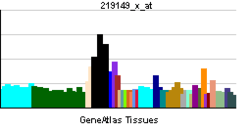DBR1
This article is about a human gene. For the automobile, see Aston Martin DBR1.
| DBR1 | |||||||||||||||||
|---|---|---|---|---|---|---|---|---|---|---|---|---|---|---|---|---|---|
| Identifiers | |||||||||||||||||
| Aliases | DBR1 | ||||||||||||||||
| External IDs | MGI: 1931520 HomoloGene: 9428 GeneCards: DBR1 | ||||||||||||||||
| |||||||||||||||||
| RNA expression pattern | |||||||||||||||||
 | |||||||||||||||||
| More reference expression data | |||||||||||||||||
| Orthologs | |||||||||||||||||
| Species | Human | Mouse | |||||||||||||||
| Entrez | |||||||||||||||||
| Ensembl | |||||||||||||||||
| UniProt | |||||||||||||||||
| RefSeq (mRNA) | |||||||||||||||||
| RefSeq (protein) | |||||||||||||||||
| Location (UCSC) | Chr 3: 138.16 – 138.17 Mb | Chr 9: 99.58 – 99.58 Mb | |||||||||||||||
| PubMed search | [1] | [2] | |||||||||||||||
| Wikidata | |||||||||||||||||
| View/Edit Human | View/Edit Mouse |
Lariat debranching enzyme is a protein that in humans is encoded by the DBR1 gene.[3][4]
The RNA lariat debranching enzyme, or DBR1, specifically hydrolyzes 2-prime-to-5-prime branched phosphodiester bonds at the branch point of excised lariat intron RNA and converts them into linear molecules.[supplied by OMIM][4]
References
- ↑ "Human PubMed Reference:".
- ↑ "Mouse PubMed Reference:".
- ↑ Kim JW, Kim HC, Kim GM, Yang JM, Boeke JD, Nam K (Sep 2000). "Human RNA lariat debranching enzyme cDNA complements the phenotypes of Saccharomyces cerevisiae dbr1 and Schizosaccharomyces pombe dbr1 mutants". Nucleic Acids Res. 28 (18): 3666–73. doi:10.1093/nar/28.18.3666. PMC 110720
 . PMID 10982890.
. PMID 10982890. - 1 2 "Entrez Gene: DBR1 debranching enzyme homolog 1 (S. cerevisiae)".
Further reading
- Chapman KB, Boeke JD (1991). "Isolation and characterization of the gene encoding yeast debranching enzyme.". Cell. 65 (3): 483–92. doi:10.1016/0092-8674(91)90466-C. PMID 1850323.
- Arenas J, Hurwitz J (1987). "Purification of a RNA debranching activity from HeLa cells.". J. Biol. Chem. 262 (9): 4274–9. PMID 2435736.
- Martin A, Schneider S, Schwer B (2002). "Prp43 is an essential RNA-dependent ATPase required for release of lariat-intron from the spliceosome.". J. Biol. Chem. 277 (20): 17743–50. doi:10.1074/jbc.M200762200. PMID 11886864.
- Strausberg RL, Feingold EA, Grouse LH, et al. (2003). "Generation and initial analysis of more than 15,000 full-length human and mouse cDNA sequences.". Proc. Natl. Acad. Sci. U.S.A. 99 (26): 16899–903. doi:10.1073/pnas.242603899. PMC 139241
 . PMID 12477932.
. PMID 12477932. - Ota T, Suzuki Y, Nishikawa T, et al. (2004). "Complete sequencing and characterization of 21,243 full-length human cDNAs.". Nat. Genet. 36 (1): 40–5. doi:10.1038/ng1285. PMID 14702039.
- Gerhard DS, Wagner L, Feingold EA, et al. (2004). "The status, quality, and expansion of the NIH full-length cDNA project: the Mammalian Gene Collection (MGC).". Genome Res. 14 (10B): 2121–7. doi:10.1101/gr.2596504. PMC 528928
 . PMID 15489334.
. PMID 15489334. - Ye Y, De Leon J, Yokoyama N, et al. (2006). "DBR1 siRNA inhibition of HIV-1 replication.". Retrovirology. 2: 63. doi:10.1186/1742-4690-2-63. PMC 1266399
 . PMID 16232320.
. PMID 16232320. - Olsen JV, Blagoev B, Gnad F, et al. (2006). "Global, in vivo, and site-specific phosphorylation dynamics in signaling networks.". Cell. 127 (3): 635–48. doi:10.1016/j.cell.2006.09.026. PMID 17081983.
This article is issued from Wikipedia - version of the 6/6/2016. The text is available under the Creative Commons Attribution/Share Alike but additional terms may apply for the media files.